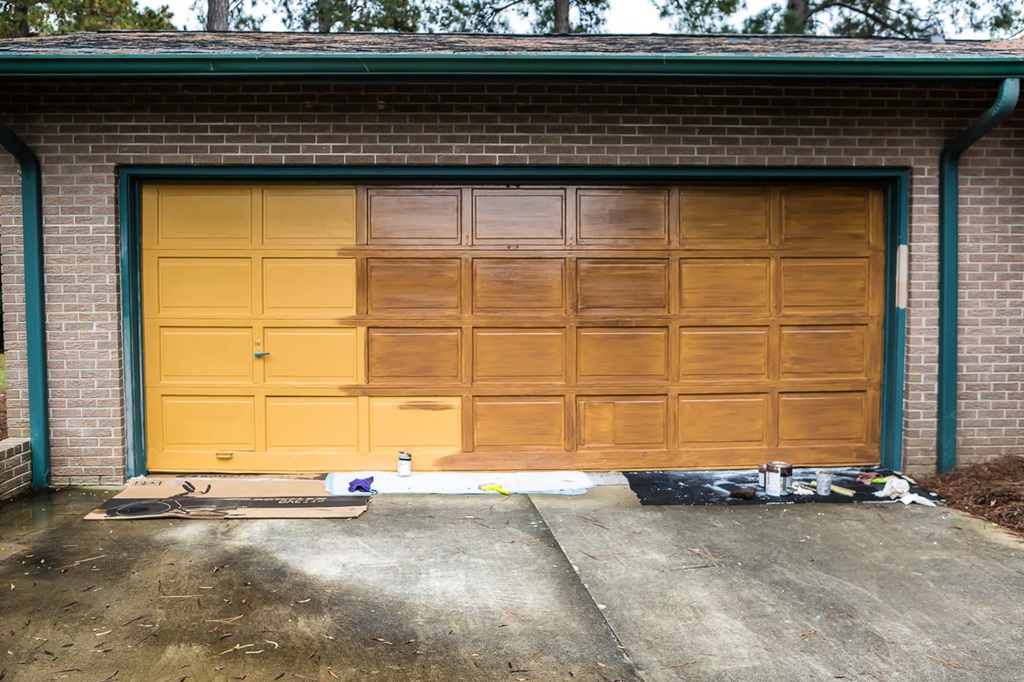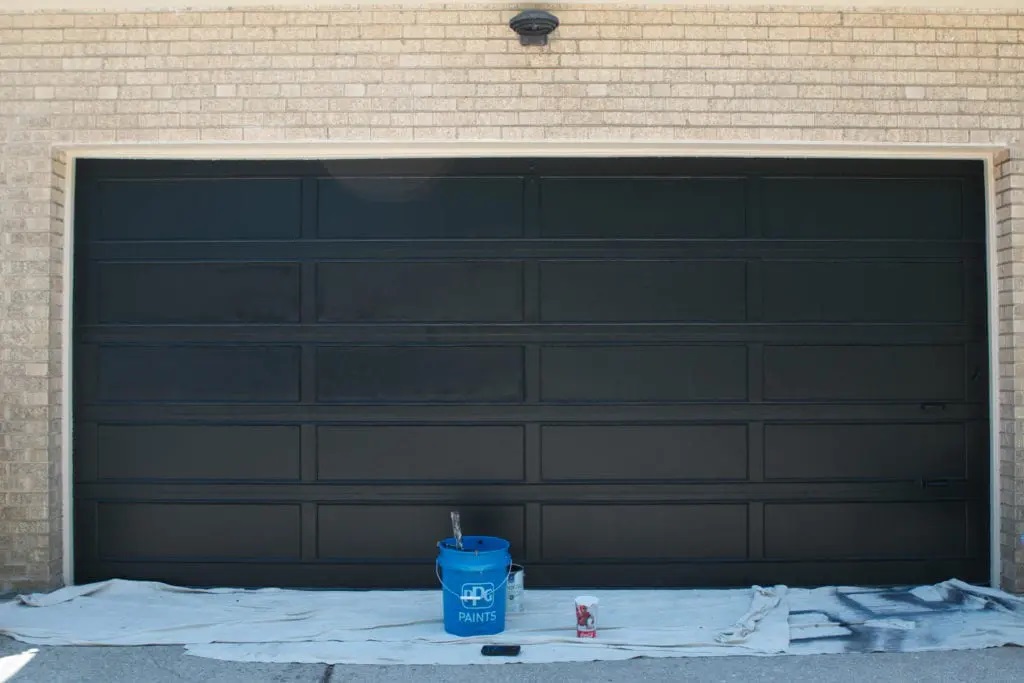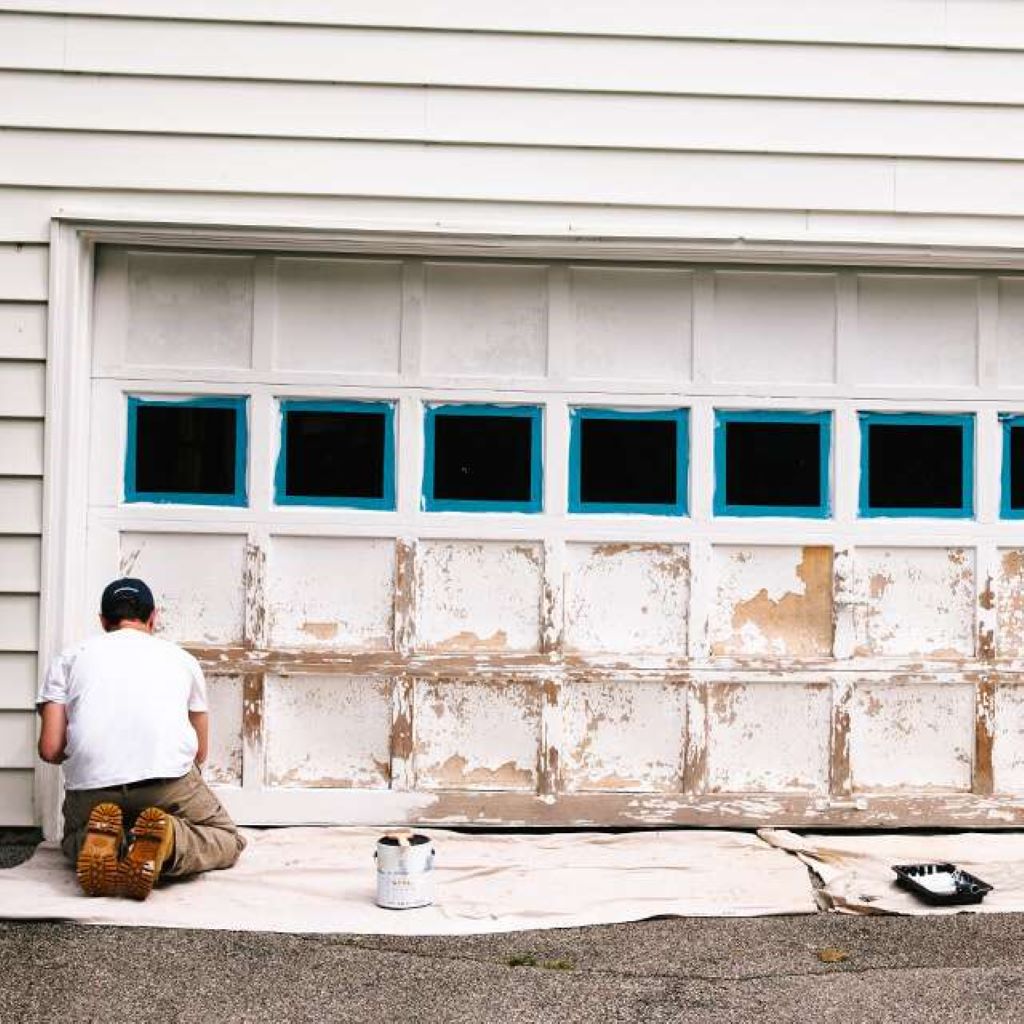
Painting your aluminum garage door can completely transform the look of your home’s exterior. While aluminum garage doors are incredibly durable, the finish can become faded, chalky and worn down over time from exposure to the elements. A fresh coat of paint is an easy and cost-effective way to restore its appearance and add curb appeal.
Painting an aluminum garage door is a project a homeowner can tackle with some preparation and the right materials. In this guide, we’ll walk through the entire process step-by-step on how to paint an aluminum garage door, from surface preparation to choosing the right type of paint, applying primer and topcoats, and ending with maintenance tips to keep your freshly painted door looking its best.
Things to Consider Before Starting

Before picking up a paintbrush, there are a few important factors to consider:
Type of Aluminum Garage Door
There are two main types of aluminum garage doors:
- Plain aluminum – These doors have a raw aluminum finish with visible seams between panels. The paint adheres well to the lightly textured surface.
- Aluminum with baked-on enamel finish – More expensive aluminum doors have a smooth, glossy baked enamel coating. This resists adhesion and requires extra preparation.
Knowing your garage door type will inform the preparation and painting process.
Condition of Existing Finish
Inspect the condition of the existing paint or enamel coating. Peeling, cracking, rusting or pitting will require more extensive surface preparation and priming. Glossy or chalky areas will also need proper prep for paint adhesion.
Climate and Exposure
Consider your home’s climate and the door’s exposure to sun, rain, snow and other elements. Areas with extreme weather require durable exterior grade paints and clear topcoat for added protection.
Single or double-car garage
The size of the door you need to paint impacts estimated costs, materials required and overall timeline.
DIY or Professional Painter
While a DIY paint job can save money, there are challenges with properly prepping and painting a large overhead door. Hiring a professional can ensure quality results and protect your safety. Evaluate your skill level before deciding.
Once you’ve considered these factors, you can determine the required supplies, tackle the prep work, and establish a game plan for completing the project.
What You’ll Need
Painting supplies for an aluminum garage door include:
- Drop cloths – Protect ground and plants from paint drips
- Paint scraper – For removing loose paint
- Sandpaper – Both coarse (60-80 grit) and fine (120-220 grit)
- Tack cloth – For wiping away dust between sanding
- Paint solvent – Such as mineral spirits for cleaning the surface
- Primer – Specifically formulated for metal
- Exterior enamel paint – For topcoat
- Paint brushes – Various sizes for cutting in edges
- Paint rollers – 1/4″ nap for smooth finish
- Paint tray – To hold paint while using roller
- Painter’s tape – For edging and masking windows
- Caulk gun & silicone caulk – For sealing joints/gaps if needed
- Rags & paint thinner – For cleanup
- Paint stick or pole + attachment – For reaching top of the door
Buy quality primer and paint designed for metal exterior use, appropriate for your regional climate. Depending on door size, you may need 1-2 gallons of primer and 1-2 gallons of paint.
Safety gear like gloves, goggles, and a mask is also recommended when scraping, sanding and painting.
Preparing an Aluminum Garage Door for Painting
Proper preparation is crucial for getting great results from painting your aluminum garage door. It provides the proper surface profile for maximum paint adhesion. The level of prep varies slightly depending on whether you have a plain aluminum door or one with a baked enamel finish.
Follow these steps to prepare an aluminum garage door for painting:
Clean and Inspect the Surface
Use a regular garden hose to wash away built-up dirt, cobwebs and debris. Pay attention to the crevices where panels meet. Allow the door to fully dry.
Next, inspect for any flakes or blisters in the existing paint or enamel coating. Check for rust spots, pitting, cracking or other damage. Make notes on areas needing extra prep work.
Remove Hardware
Using a screwdriver, remove any handles, locks, cable fixtures and decorative hardware attached to the door. Set them aside in a safe place, along with any screws or fasteners.
Lightly Sand Plain Aluminum
For raw aluminum doors, use 120-150 grit sandpaper to scuff the metallic surface. This helps the primer grip. Avoid removing more material than needed. Wipe clean with a tack cloth when done.
Heavily Sand Baked Enamel Finish
Garage doors with baked enamel require heavy sanding to rough up the ultra-smooth surface. Start with 60-80 grit sandpaper to remove the glossy top layer. Then, use 120-150 grit to feather and blend the edges. Finish with 220 grit for a smoother profile. Wipe clean with a tack cloth.
Scrape Off Flaking Paint
Use a paint scraper to remove any loose, cracking or peeling sections of old paint. Get down to the bare metal surface. Feather the edges smooth.
Spot Clean Grease and Oils
Clean any oily deposits or greasy grime with mineral spirits and rags. Let it fully evaporate.
Spot Prime Bare Metal/Rust
Use a small foam brush to spot and apply primer to any exposed bare aluminum, rust spots, or freshly scraped areas. This prevents new rust from forming before the overall priming stage.
Fill Small Holes and Gaps
For minor holes or surface pits under 1/4 inch, use a metal filler compound and putty knife to fill and smooth. For larger gaps around panels or windows, apply silicone caulk. Let repairs fully cure before sanding smooth.
Mask Windows, Trim and Hardware
Use painter’s tape and plastic sheeting to mask off any windows, trim pieces, or hardware you don’t want to be sprayed. This keeps them pain-free.
Clean Surfaces with Tack Cloth
Wipe the entire door down with a tack cloth after cleaning, scraping, sanding and spot priming. This removes all dust and debris before primer application.
Now, the aluminum garage door surface is prepped and ready for painting!
Choosing the Right Metal Primer
Applying primer is one of the most important steps when painting a metal garage door. The right primer increases paint adhesion and prevents premature peeling and blistering.
There are two main options for effective aluminum garage door primer:
Etching Primer
- It contains phosphoric acid that etches into the metal surface for superior grip
- Ideal for glossy or slick baked enamel finishes
- It provides excellent corrosion resistance
- Best for new aluminum and rust-free surfaces
Rust-Inhibiting Primer
- Formulated with rust inhibitors and anti-corrosive pigments
- Bonds well to lightly rusted metals
- Stops existing rust and prevents new rust
- Best for older or weathered aluminum doors
Within these categories, look for primers specifically made for exterior application on aluminum and galvanized metals. Oil-based primers offer the best adhesion and durability.
For the topcoat paint, choose a similar oil or enamel-based paint also formulated for metal exterior use. The brands, sheens and colors should be compatible.
Consult with your local paint supply store for the ideal primers and paints for your particular door type, condition, and climate.
Applying Primer to the Aluminum Garage Door
Once you’ve prepped the surface and chosen your primer, it’s time to apply it. Follow these steps for priming an aluminum garage door:
1. Read Safety Directions
Always read the primer label for necessary safety precautions related to ventilation, gear, and proper disposal of solvents. Set up painters’ ropes for safety if working from a ladder.
2. Use Drop Cloths
Cover all surrounding plants, lawn, concrete and other surfaces with drop cloths to protect from drips.
3. Stir the Primer Well
Before pouring primer into paint trays or hoppers, stir it thoroughly to incorporate any settled pigments.
4. Apply a Uniform First Coat
Use a combination of paint brushes and rollers to apply primer in a consistent first coat across the entire surface of the door, including the exterior and interior-facing sides. Get into corners and crevices. Follow the manufacturer’s instructions for drying time between coats.
5. Apply Second Primer Coat
One coat of primer is usually sufficient for properly prepped aluminum, but applying a second coat offers better corrosion resistance and improves topcoat adhesion. Let the first coat dry fully before adding the second.
6. Allow Proper Dry Time
Let the primer cure completely, checking the manufacturer’s recommended drying time. Cooler temperatures may slow the drying process. Proper dry time is key for effective adhesion.
7. Remove the Tape and Reattach the Hardware
Once fully dry, carefully remove any masking tape and plastic sheeting. Reinstall door handles and locks, and remove other fixtures before priming.
Now the aluminum door is prepped with a corrosion-resistant primer base ready for the color topcoat.
Choosing an Exterior Paint Color for Your Garage Door
Choosing an attractive, durable exterior paint color for an aluminum garage door is an important design decision impacting your home’s curb appeal. There are a few guidelines to keep in mind:
Colors That Complement Your Home’s Exterior
Select a color that works cohesively with your home’s existing color scheme, architectural style and surroundings. Popular options include:
- Matching or coordinating with home siding color
- Contrasting pop of color that complements the siding
- Neutral beige, gray, brown or white to blend with any style
- Bold, saturated colors for a striking statement
Lighter Colors vs. Darker Colors
While deep, bold paint colors can make a dramatic statement, lighter creamy whites, tans and grays show less visible dirt and wear over time on an aluminum garage door. Darker colors require more frequent touch-ups.
Sheen Level
There are a few common sheen options for exterior metal paint:
- High-Gloss – Very shiny and reflective
- Semi-Gloss – Moderate shine
- Satin – Low luster sheen
- Flat/Matte – No reflective shine
Higher gloss enamels add durability and are easiest to clean. But they also highlight surface imperfections. Satin or semi-gloss are good compromises, offering some shine while minimizing flaws.
Climate Considerations
For hot, sunny climates, choose light color paints that won’t absorb heat. In rainy humid climates, look for mildew-resistant exterior paint. Make sure the paint has proper UV resistance for durability.
If you live in an HOA community, check for any restrictions on garage door colors before selecting one.
Once you’ve selected the perfect shade, it’s time to get painting!
Painting the Aluminum Garage Door
After thorough prep work and primer application, you can now apply the exterior topcoat color. Follow these tips when painting an aluminum garage door:
1. Read Safety Precautions
Carefully follow all safety, ventilation, gear and cleanup guidelines on the paint product labeling.
2. Test Paint Color Samples
Brush out some paint samples onto the posterboard to test colors before applying them to the entire door. This allows you to confirm your color choice.
3. Use Painter’s Tape
Apply fresh painter’s tape around all interior and exterior trim pieces, hardware fixtures, and windows to protect them from drips.
4. Cut In the Edges
Use an angled trim brush to first apply paint around all edges, panels, crevices and corners. Cutting in these areas first helps prevent drips.
5. Roll On Paint
Use a roller with 1/4” nap to quickly and efficiently apply an even coat of paint across the main flat surfaces of the door. Maintain a wet edge to prevent lap marks and visible roller lines.
6. Apply Second Topcoat
For improved coverage and protection, apply two thin topcoats rather than one thick coat. Allow proper drying time per the manufacturer’s instructions before adding the second topcoat.
7. Remove Tape
Carefully remove painter’s tape from windows, trim, and hardware within 1-2 hours of painting to prevent the edges from drying and peeling up.
8. Allow Proper Cure Time
Leave the door closed and avoid opening and closing it until the paint has fully dried. Check instructions for proper cure time before parking a vehicle inside.
Follow the steps for a professional-looking finished result! Proper maintenance will keep your freshly painted aluminum garage door looking its best.

Caring for a Newly Painted Aluminum Garage Door
Now that your aluminum garage door has a fresh new coat of exterior paint, proper maintenance and care is needed to keep it looking its best. Here are some tips:
- Allow the full paint cure time before opening and closing the door, about 2-3 weeks. Slow operation avoids cracking the new paint.
- Inspect annually for signs of aging like fading, chalking, blistering or rust bubbles. Touch up as soon as deterioration appears.
- Wash regularly with a hose and non-abrasive cleaning spray to remove dirt, bird droppings and other buildup.
- Reapply a fresh coat of exterior paint every 3-5 years or whenever the existing paint shows signs of wear.
- Avoid using harsh abrasive cleaners or pressure washing as this can strip off paint.
- Inspect weather stripping seals and replace them if worn to prevent exterior moisture from seeping under the paint.
- Lubricate rollers and hinges as needed to ensure smooth door operation, reducing paint wear.
- Maintain exterior trim and caulked joints around the door to prevent moisture problems.
- In snowy climates, clear heavy accumulations with a snow brush instead of scraping to avoid damaging the painted finish.
- Garage doors tend to fade most on the top panel and exposed sun-facing side. Focus paint touch-ups here when needed.
With proper preparation, application, and maintenance, your newly painted aluminum garage door will maintain its beautiful, freshly painted look for years before needing repainting!
Frequently Asked Questions
What kind of paint should I use on an aluminum garage door?
Use 100% acrylic latex exterior grade paint or an oil-based alkyd enamel. Avoid cheaper vinyl acrylic paints. Buy quality primer and paint made specifically for metal that provides maximum adhesion, durability, and UV protection.
How long does it take for garage door paint to cure fully?
Most quality exterior paint finishes take 2-3 weeks to cure before you can operate the door entirely. Check the manufacturer’s instructions. Using the door before the paint has hardened can cause cracking.
Should I repaint the exterior and interior sides of the door?
Yes, for maximum protection, you should apply primer and paint to both sides – the exposed front exterior side and the back interior side facing inside the garage.
What temperature should it be when painting the door?
Ideally, ambient air and surface temperatures should be between 50-90°F, and extreme humidity should be avoided. Cold or hot temperatures can affect paint application and drying.
How often will I need to repaint the aluminum garage door?
Depending on your climate, every 3-5 years is typical for repainting an aluminum garage door to keep it looking fresh. More frequent touch-ups may be needed on the top panel or sun-facing sections.
Conclusion
Painting an aluminum garage door helps restore curb appeal and can transform the look of a home’s exterior. Following this guide’s techniques, you can prep, prime, and paint the door surface to get professional-quality results. Taking the proper steps for surface preparation, choosing compatible primer and paint, and applying it carefully leads to a durable, long-lasting paint job. Transforming your garage into a lush garden room not only adds a unique touch to your home but also complements the exterior, especially when maintaining the finish of your aluminum garage door with regular washing, inspection, and touch-ups ensures it looks new for years, making the painting process a worthwhile DIY project.






